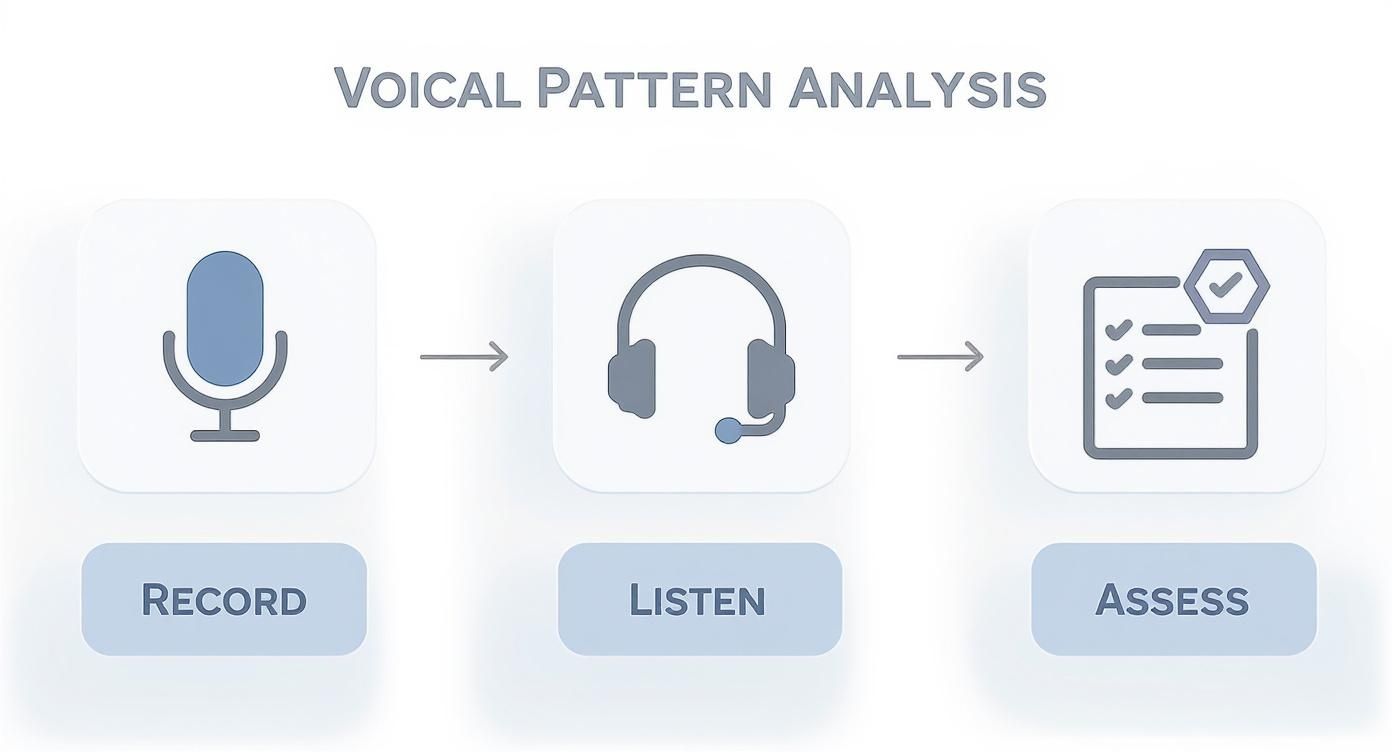How to Fix a Monotone Voice and Speak with Impact

A monotone voice isn't a "bad" voice. It just means you're speaking without much change in pitch, speed, or loudness. Think of it less as a flaw and more as a missed opportunity to add color and emotion to your words.
What a Monotone Voice Really Means

Imagine a song played using just one note on a piano. The sound itself is fine, but the melody is gone. It's flat and uninteresting. That’s what a monotone voice can feel like to a listener.
Your voice naturally has its own subtle melody, and this section will help you let it shine.
A flat vocal range is like holding one key on repeat.
When we talk about a monotone voice, we're really talking about a lack of three key ingredients:
- Pitch Variation: This is the high and low melody of your voice. It’s how you naturally emphasize important words and keep listeners tuned in.
- Pace Control: The speed of your speech creates rhythm. Speeding up can show excitement, while slowing down can build suspense or add weight to a point.
- Volume Range: Speaking louder or softer adds emotional texture and emphasis, drawing attention to what matters most.
Each of these elements works together to paint a rich, dynamic picture for your listener. A slight lift in your pitch can signal a question or excitement. A deliberate pause before a big reveal can make your audience lean in, waiting for what's next.
How Pitch, Pace, and Volume Work Together
These three elements—pitch, pace, and volume—are the building blocks of engaging speech. When they're all in play, your voice becomes a powerful tool for connection. When they’re missing, even the most fascinating topic can fall flat.
Getting a handle on this is the first real step toward unlocking your voice's full expressive potential. The payoff is huge.
- Your presentations will grab and hold attention.
- Your conversations will carry a stronger emotional connection.
- Your ideas will be more persuasive and memorable.
The goal isn't to become a different person or a dramatic actor. It's about letting the natural expressiveness you already have come through. Think of it like discovering a whole new set of colors on your vocal palette.
Why Embrace Vocal Variety
When you embrace vocal variety, something amazing happens: your confidence grows. People naturally connect more with voices that sound authentic and alive. A dynamic voice makes you sound more credible, whether you're leading a team meeting or just chatting with a friend.
Variety adds color to every conversation.
Think of your voice as a paintbrush. Every shift in tone, every change in pace, is another stroke on the canvas that helps your listener see the picture you're painting.
The journey starts right here, by simply recognizing where your voice is today. With this basic understanding, we're ready to move on to some practical diagnostics and exercises. Soon, you'll be recording your own voice to find those flat spots and start bringing every word to life.
So, Why Do We Sound Monotone? Let's Dig In.

Here’s a secret: almost nobody chooses to speak in a flat, disengaged tone. A monotone voice isn't a decision; it's a symptom. It usually comes from a mix of physical habits, psychological blocks, and learned behaviors that quietly shape how we sound to the world.
Figuring out these root causes is the first real step toward unlocking a more dynamic and expressive voice. Think of your voice as a musical instrument. If you're holding it tightly or you're too nervous to play with feeling, the music just falls flat. The same is true for speaking.
Physical Barriers Holding Your Voice Back
Sometimes, the reason for a monotone voice is purely physical. These issues can act like a limiter on an engine, capping your vocal range without you even realizing it's happening.
Here are a few of the most common physical culprits:
- Shallow Breathing: Powerful, varied speech is fueled by deep breaths from your diaphragm. When we breathe from the chest, our voice starves for air and support, leading to a weaker, flatter sound. It's that simple.
- Jaw and Neck Tension: Stress has a sneaky way of making us clench our jaw or tighten our neck. This tension literally squeezes your larynx (your voice box), choking off its natural resonance and making it tough to hit a full range of notes.
- Poor Posture: Slouching is a voice-killer. It squishes your diaphragm and constricts your airway. The fix? Sit or stand tall. This opens up your chest, giving your breath support and your voice more power and resonance.
These physical habits can easily become a vicious cycle. A tense body creates a tense voice, which makes you feel self-conscious, which leads to... you guessed it, more tension.
The Mind's Influence on Your Voice
Our emotional state has a massive impact on how we sound. For many, a monotone voice is a form of self-protection—a subconscious attempt to fly under the radar and control how others see us.
A flat voice can be an emotional shield. When we're afraid of sounding "too much"—too excited, too angry, too vulnerable—we subconsciously pull back, neutralizing our tone as a defense mechanism.
This tendency to hold back often stems from a few key places:
- Low Confidence or Social Anxiety: If you feel insecure, you might speak softly and without much inflection to avoid drawing attention to yourself.
- Fear of Judgment: Ever been told to "calm down" or been teased for showing too much emotion? That stuff sticks with you and can teach you to suppress your natural expressiveness.
- Professional Conditioning: In some corporate or academic cultures, a measured, even tone is seen as more serious and authoritative. Over time, that "professional voice" can become an ingrained habit that you can't switch off.
This all relates to the concept of prosody—the rhythm, stress, and intonation of speech. These are the very ingredients that a monotone voice is missing.
It Might Just Be a Habit
Finally, a monotone voice can simply be a habit you picked up along the way. If you grew up around people who weren't very expressive, you might have naturally adopted a similar speaking style. After years of repetition, that just becomes your default setting.
Interestingly, technology is getting better at spotting these patterns. The global voice analytics market is projected to reach USD 6.50 billion by 2032, partly thanks to tools that can measure pitch variation and flag monotonous speech. These systems are already being used in call centers and healthcare to help people communicate more effectively, highlighting voices that might struggle to keep a listener engaged. You can read a full report on the voice analytics market to see just how much this field is growing.
How a Monotone Voice Impacts Your Life
A flat vocal delivery is more than just a speaking quirk. It can have a real impact on your professional and personal life. Think about it: your voice is one of your primary tools for connection. When it lacks variety, the message people hear can be completely different from the one you're trying to send.
The Professional Cost of a Flat Tone
In a professional setting, a monotone voice can be a silent career killer. It might accidentally signal that you're disinterested, unconfident, or even untrustworthy.
Imagine a project manager presenting fantastic quarterly results, but with a flat, lifeless tone. The numbers might be incredible, but the delivery completely undermines the success. The team feels uninspired, and management starts questioning the presenter's leadership potential.
This effect isn't just limited to presentations. In a negotiation, a lack of vocal inflection can make you seem detached or unsure of your position, which instantly weakens your stance. For leaders, a monotone voice can build a wall, making it incredibly difficult to motivate a team or get people excited about a new vision. Research has shown time and again that how we say something often matters more than what we say.
The negative perceptions created by a monotone voice can put a serious cap on your career growth. People are simply less likely to be persuaded by, engaged with, or confident in someone whose voice doesn't reflect the passion behind their words.
Consider these all-too-common workplace scenarios:
- During a job interview: You could answer every question perfectly, but a flat delivery might make you seem totally unenthusiastic about the job.
- In a team meeting: You share a brilliant idea, but your monotone voice causes it to get lost in the shuffle. A minute later, someone else says the same thing with more energy and gets all the credit.
- When providing feedback: A manager with a monotone voice can struggle to sound encouraging or convey a sense of urgency, leading to miscommunication and confusion.
A monotone delivery can make you seem less credible and influential, even when your ideas are brilliant. The lack of vocal variety can be misinterpreted as a lack of engagement or expertise, putting you at a distinct disadvantage.
The Personal Disconnect in Everyday Life
The ripple effect of a monotone voice is just as significant in your personal relationships. Emotion is the glue that bonds us, and so much of that emotion is carried in the melody of our voice. When that melody is missing, it can create a real distance between you and the people you care about most.
Picture yourself trying to comfort a friend who's going through a tough time. If your voice is flat, your words of empathy can come across as robotic and insincere, no matter how much you genuinely mean them. The same goes for sharing exciting news, like an engagement or a promotion. It can fall completely flat if your voice doesn't carry the joy you're feeling inside. This disconnect can leave loved ones feeling confused or emotionally shut out.
Learning to speak with more vocal variety isn't about becoming someone you're not. It’s about making sure your voice is an accurate reflection of your true thoughts and feelings. When your voice and your intentions are aligned, you build stronger, more authentic connections, allowing you to express excitement, empathy, and affection in a way that truly lands with others.
How to Hear Your Own Vocal Patterns
Let's be honest: you can't fix what you can't hear. The first step to developing a more dynamic voice is simply to become aware of your own habits. This isn’t about being critical of yourself. It's about getting a clear, objective baseline so you can actually track your progress and see how far you’ve come.
The best way to do this is also the simplest: record yourself speaking. Our voices sound completely different inside our own heads compared to how others hear us. Listening to a recording is like taking an honest snapshot of your natural vocal patterns.
Setting Up Your Vocal Audit
To get the full picture, you need to hear yourself in a few different situations. Just grab your smartphone or any microphone and record yourself reading these three prompts aloud. Try to read them naturally, as if you were in a real conversation.
- The Neutral Statement: "The package is scheduled to arrive on Tuesday afternoon. Please make sure someone is available to sign for it between 2 PM and 4 PM." This kind of sentence shows your default speaking tone, free from any strong emotion.
- The Emotional Statement: "I cannot believe we actually did it! After all that hard work, we finally won. This is absolutely incredible news!" This one is designed to see how—or if—your voice changes when you’re genuinely excited.
- The Storytelling Prompt: "A traveler was walking down a long, dusty road when they saw a small, flickering light in the distance. Curious, they quickened their pace, wondering what they might find." This tests your ability to build a little interest and suspense.
Now, it’s time to listen. Pop in some headphones to catch all the subtle details. You'll probably want to listen to each recording a couple of times. The goal here is to be a neutral observer, just gathering data about your pitch, pace, and volume.
What to Listen For
As you play back the recordings, focus on the core ingredients of vocal variety. Don't judge what you hear—just notice it. For each recording, ask yourself these questions:
- Pitch (The Melody): Does my voice move up and down, or does it stay on one flat note? Did I naturally raise my pitch on words like "incredible" or "curious" to add emphasis?
- Pace (The Rhythm): Do I talk at the exact same speed the whole time? Or do I instinctively slow down for a serious point and speed up when I'm expressing excitement?
- Volume (The Power): Is my volume consistent, or does it rise and fall? Do I get a little louder to make a point or softer to draw someone in?
- Pauses (The Punctuation): Do I use pauses to my advantage? Or do I just rush through my sentences, leaving no time for the listener to process what I've said?
Answering these honestly gives you a solid foundation to build on. You might find your pitch is great, but you talk a mile a minute. Or maybe you use pauses well, but your volume never changes.
Establishing a baseline isn't about finding flaws; it's about identifying opportunities. Knowing your starting point makes the journey of vocal improvement measurable and much more rewarding.
Vocal Variety Self-Assessment Checklist
To make this process even more concrete, let's turn your observations into data. Use this simple checklist to score yourself after listening to a recording of your voice. Reading a short, varied passage works best.
Rate each element on a scale of 1 (Low Variety) to 5 (High Variety).
| Vocal Element | What to Listen For | Your Rating (1-5) |
|---|---|---|
| Pitch Variation | How much the high and low notes of your voice change. A low score means a flat, single-note delivery. | |
| Pace Variety | How much your speaking speed changes. A low score indicates a consistent, unchanging rhythm. | |
| Volume Dynamics | The use of loudness and softness for emphasis. A low score means speaking at one constant volume level. | |
| Use of Pauses | The strategic use of silence for impact. A low score means rushing through sentences without breaks. |
Once you've filled this out, you have it—your vocal baseline. This is your starting point. Every exercise and technique that follows is designed to help you improve these specific scores. Keep this assessment handy and plan to re-record yourself every few weeks. You'll be amazed to see just how much you can change.
Simple Exercises To Build Vocal Variety
Now that you’ve pinpointed your own speaking style, it’s time to flex those vocal muscles. Think of these workouts like a gym routine—but for your voice.
You’ll focus on three pillars—pitch, pace, and volume—and use a simple feedback loop: record, listen, assess. This continuous cycle helps you notice subtle shifts and lock in new habits.

Mastering Pitch Variation
Your pitch adds melody to your words. By playing with high and low tones, you’ll break free from monotony.
- The Vocal Siren
• How To Do It: Inhale deeply, then glide on an “ooo” or “eee” from your lowest note up to your highest—and back down.
• Why It Works: This stretch warms up your vocal cords, making it easier to tap into a wider range. Repeat 5-10 times before calls or presentations. - Emotional Exaggeration
• How To Do It: Pick a neutral line like “I’m going to the store.” First, imagine you just won the lottery—let your pitch soar. Next, try it as if confessing a secret—keep it low and hushed.
• Why It Works: You build muscle memory that links genuine feelings to vocal tone, so emotions naturally shape your pitch.
Finding Your Perfect Pace
Speed isn’t your enemy—it’s your tool. Varying your pace adds rhythm and keeps listeners hooked.
Varying pace creates a rhythm that captures attention. Speak too fast and you’ll lose clarity; too slow and you risk losing momentum.
- Speed Reading Challenge
• Read a paragraph aloud at your normal speed.
• Rush through it as fast as you can.
• Then slow it down, pausing at every comma and period. - The Storyteller’s Pause
• Read a short story or news snippet.
• Insert a one-second pause before and after key words—this trains you to use silence as a spotlight.
Incorporating these pacing drills will help you master communication skills and make your points land with greater impact.
Controlling Your Volume Dynamics
Volume isn’t just “loud” or “quiet.” It’s the texture that adds depth to your speech.
- The Projection Exercise
• How To Do It: Stand tall and speak to an imagined listener one foot away. Then project to someone ten feet away, and finally to someone across the room.
• Why It Works: You learn to engage your diaphragm for power instead of straining your throat. For a deeper dive into creating unique vocal personas, check out our guide on using an AI character generator. - The Whisper And The Roar
• How To Do It: Select a movie line or passage. Whisper the first half as if sharing a secret, then roar the second half at full volume.
• Why It Works: Shifting between extremes forces you to consciously control volume for dramatic flair.
The global voice and speech recognition market is predicted to hit USD 53.67 billion by 2030, highlighting how crucial prosody and tone are for today's applications. To learn more about how voice recognition technology is expanding and its impact, dive into the latest research.
Using Modern Tech to Improve Your Voice
Practicing vocal exercises by yourself is great, but modern technology can seriously speed up your progress. Think of AI and Text-to-Speech (TTS) tools as your own personal voice coach, ready to help whenever you are.
These tools are fantastic because they make abstract concepts like "intonation" or "pacing" concrete. Instead of just guessing what an "optimistic" or "urgent" tone sounds like, you can hear a perfect example in seconds. This gives you a crystal-clear audio target to aim for.
Using AI as Your Auditory Guide
Advanced TTS platforms have come a long way from the flat, robotic voices we used to know. In fact, the Text-to-Speech market is on track to hit USD 37.55 billion by 2032, thanks to AI that can produce incredibly realistic voices. These systems can now speak with subtle emotional cues and pitch changes, making them excellent models for anyone looking to add more variety to their speech. You can read more about these incredible TTS market trends to see how they're reshaping communication.
To start, you’ll want to find a TTS tool that lets you tweak the emotional style or delivery. Many of them allow you to type in text and simply choose a tone from a menu.
Here are a few simple prompts you can try to hear the difference for yourself:
- Prompt: "Read this sentence with a sense of optimism and excitement: 'This is the breakthrough we've been waiting for.'"
- Prompt: "Generate this line with a tone of urgency and importance: 'We need to finalize the report before the end of the day.'"
- Prompt: "Deliver this phrase with a calm, reassuring voice: 'Everything is under control, and we have a clear path forward.'"
Now, listen closely to the AI's delivery. Pay attention to how the pitch lifts on important words, how the pace picks up with urgency, or how the volume drops to sound reassuring. That's your audio blueprint.
From Listening to Speaking
Once you've generated an audio clip you like, the next step is simple: copy it. Record yourself saying the exact same sentence, and try your best to match the intonation, rhythm, and emotional flavor of the AI-generated version.
This simple loop of listening, mimicking, recording, and reviewing is unbelievably effective. It fine-tunes your ear for vocal variety and builds the muscle memory you need to start producing it without even thinking about it. For those interested in more advanced voice modification, our guide to Applio dives into some of the latest in voice AI.
Technology gives you an objective mirror for your voice. It removes the guesswork and provides clear, actionable feedback, making your practice sessions more focused and productive.
You can take this even further. Using a Speech to Text AI tool can give you hard data on your speaking patterns. When you convert your recordings to text, you can analyze your pacing and see exactly where you're pausing—or where you aren't.
Combining these two approaches—generating your ideal voice and analyzing your current one—creates a powerful system for improvement. This tech-assisted method makes learning faster, more interactive, and turns the vague goal of "fixing a monotone voice" into a clear, manageable process.
Common Questions About Changing Your Voice
Diving into the work of adding more color to your voice is exciting, but let's be honest, it can also feel a little strange at first. It’s completely normal to have questions pop up as you start building new habits. Here, I'll tackle some of the most common concerns I hear, giving you clear answers to keep you on track.
How Long Does It Take to See a Change?
There's no one-size-fits-all answer here. Your progress really depends on where you're starting from and how consistent you are. If your monotone is just a habit you've fallen into, you could hear a real difference in just a few weeks with 10-15 minutes of focused practice each day. The secret is consistent, mindful effort—not cramming it all into one long session.
Now, if a flat tone is tied to something deeper, like social anxiety or a lot of physical tension, the journey might take a bit longer. The key is to celebrate the small victories. Focus on noticing a little more pitch variation on an emotional word today, rather than expecting a complete transformation by tomorrow.
The biggest fear people have is that practicing vocal variety will make them sound fake. It might feel a bit awkward initially because it’s new, but that feeling fades as the new habit starts to feel like second nature.
Will I Sound Fake If I Try to Change My Voice?
This is probably the number one worry I hear, and it's a good one. When you first start consciously changing your pitch or pace, it can feel like you're putting on an act. That’s a totally normal part of the learning curve for any new skill, from learning to dance to speaking a new language.
The goal isn't to invent a new personality. It's about unlocking the natural expressiveness you already have inside you. A great way to start is by practicing in private, where you can feel free to exaggerate a little. With time, these new vocal patterns will blend into your natural speech, and your voice will start to reflect how you truly feel without you even thinking about it.
Could a Monotone Voice Be a Medical Sign?
For most people, a monotone voice is simply a habit or a reflection of their emotional state. That said, a sudden, dramatic change in your voice or a persistently flat delivery can sometimes be linked to certain medical conditions.
If your monotone voice shows up alongside other new physical or emotional symptoms, it's always a smart move to check in with a doctor. They can rule out any underlying issues, which gives you the peace of mind to focus on your vocal work. And for those interested in how these concepts translate to AI, there are some fascinating parallels in the strategies used for enhancing ChatGPT's tone.